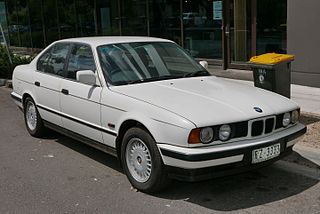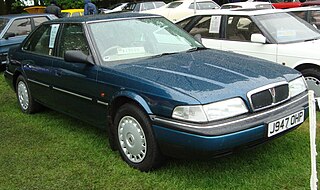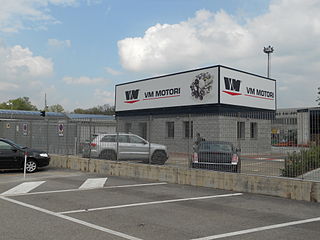BMW Marine GmbH was BMW's marine engine division. BMW's interest in marine engines dated back to 1913; they began making marine engines in 1919 after World War I.
Contents

BMW Marine GmbH was BMW's marine engine division. BMW's interest in marine engines dated back to 1913; they began making marine engines in 1919 after World War I.

In the early 1970s, marinized versions of BMW's 2.0-litre, 4-cylinder gasoline engine were marketed as the Model 410 and 411. In 1977, BMW AG established a separate marine division, incorporated as BMW Marine GmbH. BMW Marine's head office and assembly plant were located in Verviers, Belgium.
BMW Marine continued to marinize BMW's production automobile engines. BMW's 2.0-litre, four-cylinder M10 engine became the B 130, and the M30 six-cylinder engines in 2.8 and 3.3-litre variations became the B 190 and B 220 models. Later, the larger 3.5-litre M30 with electronic ignition became the B 635. Model numbers related to the engine's horsepower.
To further compete with Volvo Penta, BMW added small diesel auxiliary sail boat engines, ranging from 7 to 50 horsepower, to the BMW Marine product lineup. The engines were based on four air-cooled diesel engines manufactured by Hatz, then marinized by BMW Marine. Hurth Marine transmissions and instrument panels were added, and the resulting marine systems were marketed as the D 7, D 12, D 35, and D 50 engines. The engines were among the first in the marketplace to offer balance shaft technology, which made for a smoother running engine. Later, BMW Marine modified the two larger models to reduce the corrosion damage caused by salt water cooling. The new models were renamed the D 35-2 and D 50-2. Many of these auxiliary engines found their way into both racing and cruising sailboats made by companies such as S2, Pearson, Jonmeri, and Hans Christian. Custom yacht builders, such as Lyman Morse in the USA, also installed BMW Marine engines in their boats.

BMW Marine conspicuously needed a large diesel, especially to compete in the European power boat market. The company sourced engines from VM Motori in Northern Italy. The VM HR.H 692 block became the basis for the next series of BMW Marine engines. Most gasoline and diesel internal combustion engines bolt the crankshaft onto the bottom of the crankcase. The Vm Motori engines were unusual, in that they incorporated the crankshaft inside the crankcase. This type of construction, sometimes seen in racing car engines, is referred to as a "tunnel bore" block. It was also used in the Maybach MD870 diesel engine.
BMW Marine designed and manufactured thousands of special marine parts for the VM tunnel bore blocks. These turbocharged engines became BMW Marine's D 150 W and D 150 Z models, outputting 136 HP. A 165 HP turbocharged and intercooled D 190 was also available. The D 150 and D190 diesel engines were sold with either a Hurth 360 transmission for inboard installation or the BMW Z-Drive for stern drive applications. The D190 was later re-engineered, and with a modified Mark II Z-Drive, was sold as the BMW D 636 Z with 180 HP. Following this, a five-cylinder 3.0-litre version of the 3.6-litre six was offered as the BMW D 530. In England, Fairline and Plancraft offered their products with BMW Power. In America, Ken Hopen's GlasPly plant in Washington state featured both BMW gasoline and diesel engines with BMW Z-Drives in his product line.
BMW Marine, in conjunction with ZF, designed and manufactured a new stern drive unit. These stern drives were marketed as the BMW Z-Drive. Uniquely, these stern drives utilized a multiple wet clutch system. These drives competed with Sweden's Volvo Penta and Mercury Marine's Mercruiser Division of Stillwater, Oklahoma.
Engines came from VM Motori in Northern Italy, such engines were also used in the Maybach MD870 diesel engine. [1]
With a downturn in the automotive market in 1987, and a lack of significant success in the recreational marine market, BMW decided to close the marine division. The Belgium plant and assets were sold to Mercury Marine of Fond du Lac, Wisconsin [2] . BMW further signed a parts distribution agreement with Mercury to ensure the continued supply of parts to BMW Marine engine owners. Mercury continued production of the BMW five- and six-cylinder diesel engines. The BMW D 530 and D 636 became the Mercruiser 530 D-TA and 636 D-TA. Mercury later changed the designations to D183 and D219 TURBO AC. Mercury continued where BMW Marine had left off, improving on these VM based engines. In the early 1990s they offered a larger 4.2-litre diesel designated the D254 Turbo AC. The designation '254' related to the displacement of the engine in cubic inches. As of 2008, variations of the original 3.6-litre engines became the Mercruiser D4.2L/220 IDI six-cylinder diesel. Parts for BMW Marine engines continue to be available from Mercury Marine and their subsidiary, Marine Power, in Belgium. Some of the original 200 BMW Marine dealers worldwide continue to service and sell parts.


The radial engine is a reciprocating type internal combustion engine configuration in which the cylinders "radiate" outward from a central crankcase like the spokes of a wheel. It resembles a stylized star when viewed from the front, and is called a "star engine" in some other languages.
The straight-five engine is a piston engine with five cylinders mounted in a straight line along the crankshaft.

The BMW E34 is the third generation of the BMW 5 Series, which was produced from November 2, 1987, until 1996. Initially launched as a sedan in January 1988, the E34 also saw a "Touring" station wagon (estate) body style added in September 1992, a first for the 5 Series. BMW replaced the E34 with the E39 5 Series in December 1995, although E34 Touring models remained in production until June 1996.

The Rover 800 series is an executive car range manufactured by the Austin Rover Group subsidiary of British Leyland, and its successor the Rover Group from 1986 to 1999. It was also marketed as the Sterling in the United States. Co-developed with Honda, it was a close relative to the Honda Legend and the successor to the decade-old Rover SD1.

The BMW 6 Series is a range of grand tourers produced by BMW since 1976. It is the successor to the E9 Coupé and is currently in its fourth generation.

The BMW E12 is the first generation of 5 Series executive cars, which was produced from 1972 to 1981 and replaced the saloon models of the BMW New Class range.

The BMW E23 is the first generation of the BMW 7 Series luxury cars and was produced from 1977 until 1986. It was built in a 4-door sedan body style with 6-cylinder engines, to replace the BMW 'New Six' (E3) sedans. From 1983 until 1986, a turbocharged 6-cylinder engine was available.

The BMW E28 is the second generation of BMW 5 Series executive cars, which was produced from 1981 to 1988 and replaced the E12 5 Series. Pre-series production began in April 1981 and the car was introduced in the autumn that year.

The third generation of the BMW 3 Series range of compact executive cars is designated under the model code E36, and was produced by the German automaker BMW from 1990 to 2000. The initial models were of the four-door sedan body style, followed by the coupé, convertible, wagon ("Touring"), and eventually hatchback ("Compact").

VM Motori S.p.A. is an Italian diesel engine manufacturing company which is wholly owned by Stellantis. VM headquarters and main production facilities are located in Cento, in Emilia-Romagna, Italy.

The BMW X3 is an SUV manufactured by BMW since 2003, based on the BMW 3 Series platform. Now in its third generation, BMW markets the car as a Sports Activity Vehicle, the company's proprietary descriptor for its X-line luxury vehicles.

Mercury Marine is a marine engine division of Brunswick Corporation headquartered in Fond du Lac, Wisconsin. The main product line is outboard engines. It also produces the MerCruiser line of sterndrives and inboard engines. As well as an all new lineup of electric outboard motors utilizing 48V lithium-ion modular and portable designed batteries. Implementing an industry-first transverse flux motor technology, yielding high torque with optimum efficiency. Some manufacturing is in Fond du Lac, while 40-60 HP engines are made in China. Smaller engines are Tohatsus that have been rebadged.

A sterndrive or inboard/outboard drive (I/O) is a form of marine propulsion which combines inboard power with outboard drive. The engine sits just forward of the transom while the drive unit lies outside the hull.

Alpina Burkard Bovensiepen GmbH & Co. KG is an automobile manufacturing company based in Buchloe, in the Ostallgäu district of Bavaria, Germany that develops and sells high-performance versions of BMW cars. Alpina works closely with BMW and their processes are integrated into BMW's production lines, and is recognized by the German Ministry of Transport as an automobile manufacturer, in contrast to other performance specialists, which are aftermarket tuners. The Alpina B7 is produced at the same assembly line in Dingolfing, Germany, as BMW's own 7 Series. The B7's twin-turbo 4.4-litre V8 is assembled by hand at Alpina's facility in Buchloe, Germany, before being shipped to BMW for installation, and the assembled vehicle is then sent back to Alpina for finishing touches.

An inboard motor is a marine propulsion system for boats. As opposed to an outboard motor where an engine is mounted outside the hull of the craft, an inboard motor is an engine enclosed within the hull of the boat, usually connected to a propulsion screw by a driveshaft.

Diesel engines began to be used in automobiles in the 1930s. Mainly used for commercial applications early on, they did not gain popularity for passenger travel until their development in Europe in the 1950s. After reaching a peak in popularity worldwide around 2015, in the aftermath of Dieselgate, the diesel car rapidly fell out of favor with consumers and regulators.
A tunnel crankcase, tunnel crankshaft or disc-webbed crankshaft is a design feature of a piston engine where the main bearings that support the crankshaft within the crankcase form the largest diameter of any part of the crankshaft and are larger than the crank webs. This requires a crankcase with a large tunnel instead of cross web supports for narrower main bearings, hence the name.